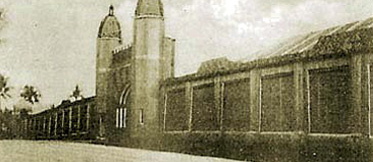Visual Artifacts of Pudu Jail
The historic Pudu prison was built and designed in 1891 and completed in 1895 by state engineer and director of Public Works Department, Charles Edwin Spooner. At the cost of RM 138 000 ($320 000), the prison was built in six phases using steel, brick and cement, all imported from British colonies (1). During World War II, the Japanese occupation forces incarcerated many English, Australian and New Zealand prisoners in this prison. In 1981, it saw the execution of legendary robber “Botak Chin”, in 1986, the execution of Kevin Barlow and Brian Chambers, Australian nationals, for the drug trafficking of heroin.

Pudu stands as an icon and important symbol of our design history. A design icon, its building eerily shaped like a person surrendering, with arms and legs wide open (aerial view). The front gate depicts Moorish architecture in its two domed towers. In 1970s, watch towers were built to a vernacular style with jagged edges and pointed roofs called the Minangkabau on the east and west prison walls. A relic of the Victorian period, Pudu Jail’s architecture is strongly influenced by British colonial prison structure and design which emphasizes security and manual operation. (3)
Pudu’s own prisoner, Khong Yen Chee painted the impressive murals on walls surrounds the prison, an act that is a symbol of what role Pudu has played in the development of our visual landscape. The mural took a year to complete using 2000 litre’s of paint. San-serif font used in all signages and serif fonts used in painted information graphics. The styles of the murals represented its era, its design culture in the early 1980s.
Click here to view photographs by Rafiq Ghazali
* Pudu was demolished on the 14th October 2009 to make way for road expansion. The final wall came down at 10pm, 21 June 2010.
[Watch out for "Beyond Bars KL's Pudu Prison" on the 26th December 2010, 10pm on History Channel (555).]

No comments:
Post a Comment